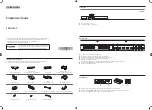
Circuit Descriptions, Abbreviation List, and IC Data Sheets
EN 131
FTL2.1E, FTL2.2E
9.
•
OUT:
The set is OUT when the mains cord is disconnected.
When the mains cord is connected, the set goes to OFF or
to STAND-BY state, depending on the last status in the
NVM. From all states, the set can be set to the OUT state
by disconnecting the mains cord or by a mains interruption.
•
OFF:
In the OFF state, the OTC is powered but is in low
power STAND-BY state. No LEDs are "on", RC6 is
ignored, no EPG or P50 is possible, Proximity is set to "off",
time extraction is not started (if it was done before this
state, the clock stays running). This state can only be
changed by the tact switch; the set goes via SEMI-STAND-
BY to ON. From all states, we can go to the OFF state by
the tact switch.
•
STAND-BY:
The set is in STAND-BY if the STAND-BY bit
is set. This state can change with the RC6 "on" command,
for EPG loading, P50 recording, for time extraction, or for
ambient light. The next state is SEMI-STAND-BY and to
ON if the STAND-BY bit is not set.
•
SEMI-STAND-BY:
State between STAND-BY or OFF and
ON state. All supply voltages are present, but the screen is
blanked.
•
ON:
set is ON.
9.2.5
POR detection
Situation in 2003:
By starting up or switching "off" the set by the ON/OFF switch
or with (dis)connecting the mains cord, the power supply
generates a POR. In case of mains spikes within the limits,
there should be no POR. The POR line is "high" by starting up
and shutting down and is "low" when the set is "on". This line
mutes the audio amplifier and the audio outputs. The POR is
also inverted and sent to the OTC (POR_FLASH). After a POR,
the software starts the set, and there is a delay of 1 s after
switching "off" for the backlights.
Changes in 2004:
Since the ON/OFF switch is always closed (not present
anymore), there is no POR by starting up. The POR line is
connected to +5V2 and is always "high". Only when the mains
cord is reconnected, the Stand-by supply starts up, and the
POR line follows the start up of the 5V2.
9.3
Video
For a detailed description of the Feature Box (PICNIC,
Columbus, FEM, and Eagle 1C), see the EM5.3 Service
Manual.
9.4
Synchronisation
See the FTL13 manual for a (more) detailed description.
9.5
Audio
See the FTL13 manual for a (more) detailed description.
9.6
Control
See the FTL13 manual for a (more) detailed description.
9.7
Proximity Sensor (if present)
9.7.1
Introduction
The function of Proximity Sensor is to detect a motion when the
customer is approaching the set. It will then light up the LEDs
on the set for 6 s (detection area is 1.5 - 2 m). Its functionality
is based upon IR emission, IR detection, and LED lighting
processes. These three different phases are defined as
follows:
1.
First, it emits a signal through an IR transmitter.
2.
Then it detects a reflection of this signal caused by a
person approaching the set.
3.
Finally, it lights up the different LEDs.
There are two IR transmitters used to cover the complete front,
and detection is done with the existing IR receiver. It detects
the reflected signal coming from the customer when he/she is
approaching the set. If the customer presses a button on the
keyboard of the Top Control, the lighting phase is also
activated (or re-triggering).
The output of the module will control the lighting of the LED with
a fade in/out effect.
The function can be switched “off/on” in the set-up menu.
The module is powered by the 5V_STAND-BY and works in
“Stand-by” and in “On” state.
The control of the proximity sensor is done by a separate
microprocessor. The communication between this processor
and the OTC is done by the RC5 line. The following info is sent
via this line:
Figure 9-6 Pulses proximity microprocessor.
•
Proximity OFF: negative pulse of 20 ms. The feature is
switched "off" -> no detection.
•
Proximity ON: negative pulse of 40 ms. The feature is
turned "on" -> detection possible.
•
Keyboard pressed: negative pulse of 60 ms. This gives a
command to the proximity uP to turn "on" the LEDs.
•
OTC goes to STAND-BY: negative pulse of 80 ms. This
gives an indication that the set is in "Stand-by" mode.
OFF
ON
STDBY
KeybP
20ms
40ms
60ms
80ms
E_14620_019.eps
290404
















































